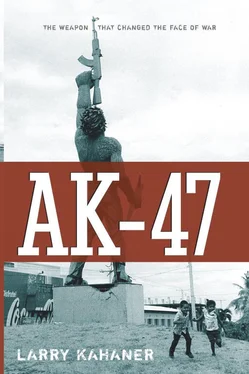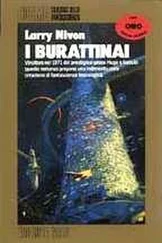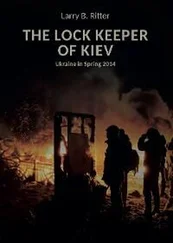Larry Kahaner - AK-47
Здесь есть возможность читать онлайн «Larry Kahaner - AK-47» весь текст электронной книги совершенно бесплатно (целиком полную версию без сокращений). В некоторых случаях можно слушать аудио, скачать через торрент в формате fb2 и присутствует краткое содержание. Город: Hoboken, Год выпуска: 2007, ISBN: 2007, Издательство: John Wiley & Sons, Inc., Жанр: История, military_history, на английском языке. Описание произведения, (предисловие) а так же отзывы посетителей доступны на портале библиотеки ЛибКат.
- Название:AK-47
- Автор:
- Издательство:John Wiley & Sons, Inc.
- Жанр:
- Год:2007
- Город:Hoboken
- ISBN:9780470315668
- Рейтинг книги:3 / 5. Голосов: 1
-
Избранное:Добавить в избранное
- Отзывы:
-
Ваша оценка:
- 60
- 1
- 2
- 3
- 4
- 5
AK-47: краткое содержание, описание и аннотация
Предлагаем к чтению аннотацию, описание, краткое содержание или предисловие (зависит от того, что написал сам автор книги «AK-47»). Если вы не нашли необходимую информацию о книге — напишите в комментариях, мы постараемся отыскать её.
AK-47 — читать онлайн бесплатно полную книгу (весь текст) целиком
Ниже представлен текст книги, разбитый по страницам. Система сохранения места последней прочитанной страницы, позволяет с удобством читать онлайн бесплатно книгу «AK-47», без необходимости каждый раз заново искать на чём Вы остановились. Поставьте закладку, и сможете в любой момент перейти на страницу, на которой закончили чтение.
Интервал:
Закладка:




Stamping has limitations, however. Newer, harder composites won’t accept stamping at all, and imprinting through injection molding does not allow enough detail in a small area to be practical. Laser marking has become the state of the art because of its precision and ability to imprint a lot of information, even bar codes. NASA and private industry have developed a two-dimensional digital image matrix that contains tiny black and white squares representing binary digits that describe a part number. NASA’s goal was to place these identification markers on even the tiniest parts used in the space program. Unlike bar codes, these matrix Unique Identifications, or UIDs, are scalable; they can be produced very large or microscopically small and still maintain their readability. They can hold more than one hundred times the amount of information of a typical bar code. The U.S. Army Armament Research and Development Center is testing these UIDs on M-16s and other matériel, because they can be read even after they have been damaged.
Lasers also allow marking on more expensive-to-replace, harder-to-reach parts of a firearm so that any grinding down of the area to obliterate the marking would make the firearm unusable. Some suggest placing laser markings on the breechblock or bolt. This would serve several purposes: it would be hidden until the gun was broken down; erasing the marking might render the part unusable; and replacing it with an unmarked bolt would be costly.
Many U.S., Canadian, and European gun makers routinely employ laser marking to imprint weapons quickly, about three firearms per minute. Costs are low, too, a few cents per weapon in large quantities once the imprinting machine is amortized at a cost of between $40,000 and $60,000. Stamping is less susceptible to erasures because the molecular structure of the metal is deformed much deeper by stamping than from a laser. On the other hand, laser marking is faster and some companies imprint markings with tiny laser holes that can go much deeper than a stamped imprint.
Although marking is one solution to illegal arms trafficking, it would be meaningless without a worldwide database and registry. Such a registry would require that all markings become standard—harmonization, as it’s called—but chances are slim of this occurring in the near future because mandatory participation among all nations would be difficult to obtain.
At the 2001 UN meeting, Bob Barr noted that the United States has some of the world’s most stringent laws concerning firearms marking, mandating the inclusion of the location, manufacturer’s name, and serial number. He suggested that other countries would do well to follow the U.S. lead in controlling exports. Barr held firm against an international registry, though, which he compared to internationally forced gun registration. “That is completely unacceptable, and I and others in the Congress will work to ensure any system of marking firearms focuses on eliminating illegal firearms trafficking, and does not allow the United Nations to create any system which registers or tracks U.S. gun owners or sales.”
At a June 2005 UN small-arms working group meeting on marking and tracing, attendees spent a great deal of time discussing the subject of ammunition marking. Proponents argued that while firearms were rarely left at the scene of crimes, shell casings often were, and bullets could be retrieved from victims’ bodies. If these bullets could be traced to the buyer, investigators would have a solid tool at their disposal.
Although many ammunition makers argue that marking each round would be prohibitively expensive, those in favor of marking note that cartridges are already imprinted successfully with some letters and numbers, sometimes the caliber size, manufacturer’s symbol, or some other identifier. German and Brazilian military ammunition buyers insist on further identification from their suppliers. They require that 5.56 × 45mm rounds for AK-102 and M-16 rifles be marked with the caliber and a ten-digit code composed of six numbers and four letters identifying the manufacturer, year and month of production, lot size, and a unique lot identifier.
Such intricate marking does impose additional expense. Simple markings such as manufacturer or year are traditionally applied by a piston that mechanically presses numbers and letters when the primer pocket is being formed by the same thrusting motion. These stamps only need changing annually. Not so with stamping of lot numbers. Assembly lines, which can hold up to ten thousand cartridges during the assembly process, must be stopped, current cartridges taken off the line, new stamps inserted, and the process begun anew. This is the only way to make sure that lot numbers are not mixed together, but it is time-consuming and slows production lines.
Brazil has decided to buck convention, however. Effective in January 2005, a Brazilian law required identification of eleven different calibers of ammunition to include the lot number as well as a code that identifies the buyer as armed forces, police, private security services, or sport shooting organizations. The calibers were those used in small arms including handguns, assault rifles, and machine guns. In addition, ammo boxes had to contain a bar code so the manufacturer and purchaser could be traced.
This move was in response to Brazil’s high rate of domestic gun-related murders. About thirty-five thousand to forty thousand Brazilians are killed annually by guns. Gun murders, mainly using handguns, are the leading cause of death in that nation, according to a recent study of fifty-seven countries conducted by the United Nations.
At the time of writing many of these shootings take place in the favelas, or shantytowns, of Rio de Janeiro. The government has lost control of these makeshift neighborhoods, some eight hundred or so with 1.2 million inhabitants, and gangs have taken over. Armed youths carrying automatic weapons patrol their turfs; some belong to paramilitary groups, while others are part of drug gangs. Still others belong to loose amalgams of poor people trying to protect what little they own with whatever small arms they can afford. Often, military police raid these shantytowns, looking for drug dealers and criminals, and hundreds of innocent people are killed each year by stray bullets from both government and nongovernment shooters.
Amid this dreadful situation, Brazilian officials have instituted some of the most restrictive gun laws in the Western Hemisphere. Only police and other law enforcement officials are permitted to carry firearms in public (some hunters are exempt). The minimum age for owning weapons has been raised from twenty-one to twenty-five, and those caught carrying weapons are subject to prison sentences of two to four years. The government also established a gun buyback program that made it more expensive to register a weapon than to turn it in for cash, $30 for handguns to $100 for assault rifles. One woman reportedly received $65,000 in 2004 for her deceased father’s collection of more than twelve hundred guns.
More important, at the time of writing, it is now possible in Brazil to trace ammunition used in crimes. One manufacturer, Companhia Brasileira Cartuchos (CBC), has already begun imprinting ammunition in compliance with the new marking law. The company uses lasers to imprint a five-digit code into the cartridge’s extractor groove, which provides a tiny grip for the gun’s extractor to pull the empty case from the chamber after firing. Using computer-directed lasers to imprint the codes does not slow down the assembly process, because once a lot has been produced, it is set aside for imprinting. Once the lot is finished, another lot can be imprinted with its own specific code. Numbers are recorded automatically by a computer for record-keeping purposes. Because marking is accomplished after production, even imported ammunition can be easily imprinted once it enters the country. To ensure tracing capabilities and prevent stealing, producers and importers are required to give “read-only” database information immediately to police and military commands. It is too early to tell if the new gun- and ammunition-marking laws will prevent gun violence, but legislators have high hopes.
Читать дальшеИнтервал:
Закладка:
Похожие книги на «AK-47»
Представляем Вашему вниманию похожие книги на «AK-47» списком для выбора. Мы отобрали схожую по названию и смыслу литературу в надежде предоставить читателям больше вариантов отыскать новые, интересные, ещё непрочитанные произведения.
Обсуждение, отзывы о книге «AK-47» и просто собственные мнения читателей. Оставьте ваши комментарии, напишите, что Вы думаете о произведении, его смысле или главных героях. Укажите что конкретно понравилось, а что нет, и почему Вы так считаете.











